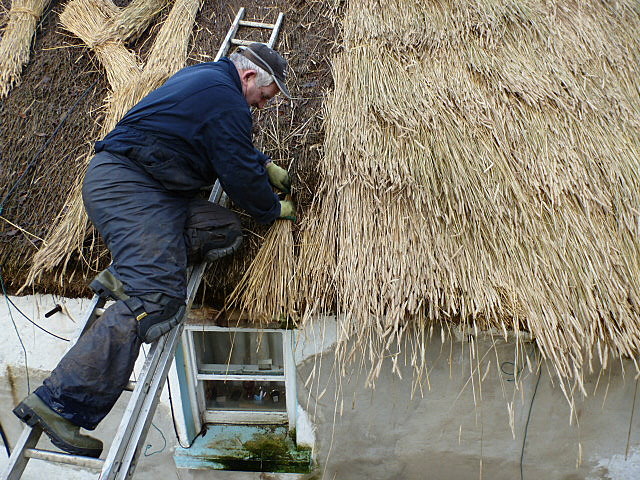A window of crispy cold and miraculously dry weather opens in late November.
Some people have been waiting since late summer for the gift of such dryness – to mend roofs.
I head up the hills overlooking Killybegs until the road will go no further.
Here I find Martin Mc Brearty thatching a long house.
Thatching is done using oat, wheat, rye and barley, flax, water reeds and in the old days using whatever fiber was at hand – marram grass from the shore or plain bog rushes were in common use in Donegal. Today Martin is using rye – grown in Raphoe, Donegal.
West coast cottages have roped thatch – loose bundles of straw roped down against prevailing winds. This roof was last thatched about nine years ago and has sprung a couple of leaky spots.
 To make the bottom edge Martin fastens bunches by burying the seed head end of the straw into the old thatch.
To make the bottom edge Martin fastens bunches by burying the seed head end of the straw into the old thatch.
Over a foot deep – you can see that the oldest layer (two hundred years old) is as dry as a bone. Thatch provides excellent insulation and indeed the warmth can be felt immediately upon entering this cottage – despite there being no range or fire lit since the previous evening.
The whole roof is covered by chicken wire (it would have been net previously) and lashed to pegs to the eaves.
Martin was raised under thatch – so he knows this job since he was a boy – with continuous patching of the family dwelling needed.
Subsequent rows of straw are laid evenly on top of the old thatch, but with the stalks now skyward. He works from right to left, from bottom to top.
The trick is to get the bunches evenly spread, without creating pits or troughs where water can collect. He makes it look easy.
The edges are trimmed with garden shears.
The apex of the roof is rounded – a typical feature of houses set close to the sea – with lathes holding the net secure below.
Meanwhile at a cottage not far away –
Spanish slate is in use.
The compromise is this – while lacking the traditional integrity and beauty of thatch, slate requires much less maintenance.
Maybe when it comes to rebuilding the donkey byre a wee thatch will do.















cool as Louise as usual
Always enjoy viewing your posts on this blog. Thank you for this very informative story on the process used to do thatching. I have been interested in this for a while and yours gives the most info I’ve seen so far.
Impressive explanation of the technical detail, usually omitted in paeans in praise of thatch. I hope that the byre does get its thatch back, lucky donkey.
God bless your hands, Martin. A beautiful job and its lovely to see. Louise the cottage is sucking diesel, the shape thats on it, is just fanfeckingtastic. I have to get over to it this weekend.
FANTASTICALLY INSPIRING! As usual. You make me feel so utterly at home. xoxo
So that’s how its done!
We live under an ageing thatch roof, I think it’s reed, lots of them growing around us here in the Cambridgeshire Fens. If our landlord doesnt do it I might have a go myself, now!
But, why is Spanish slate being used on your cottage, I thought there might be Irish slate available, or Welsh if not? Either way, I admire your Blog site, the information is clear and the photo’s are lovely, thank you.
Alas no Irish slate mine endures commercialy. Welsh slate is double as dear as Spanish slate. We are talking about a doubly higher quality slate with a hundred year guarentee (fifty on the Spanish). Compromise at every turn.
Your reed thatch should have a lifespan of 30-50 yrs!
A friend alerted me to this wonderful heritage site in Scotalnd where the thatch was of bracken – and in special cases heather.
http://naturalhomes.org/leanach.htm